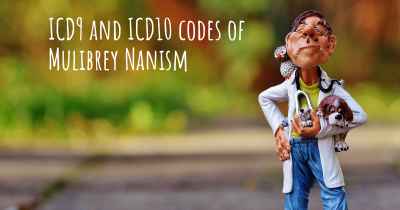What is the history of Mulibrey Nanism?
When was Mulibrey Nanism discovered? What is the story of this discovery? Was it coincidence or not?

Mulibrey Nanism:
Mulibrey Nanism is a rare genetic disorder that affects growth and development. It is characterized by a combination of distinctive features including severe growth retardation, muscle weakness, and various organ abnormalities. The name "Mulibrey" is an acronym derived from the main clinical features of the disorder: MUscle, LIver, BRAin, and Endocrine abnormalities.
Discovery and Naming:
Mulibrey Nanism was first described in the medical literature in 1974 by Finnish pediatrician Arvo Sulamaa. He reported a case of two siblings with similar clinical features, including growth failure, liver dysfunction, and characteristic facial appearance. Sulamaa named the disorder "Mulibrey Nanism" to reflect the major organ systems affected by the condition.
Cause and Genetics:
Mulibrey Nanism is caused by mutations in a gene called TRIM37, which is located on chromosome 17. This gene provides instructions for producing a protein that is involved in various cellular processes, including the regulation of growth and development. The specific mechanisms by which TRIM37 mutations lead to the characteristic features of Mulibrey Nanism are not fully understood.
Prevalence and Inheritance:
Mulibrey Nanism is an extremely rare disorder, with only a few hundred cases reported worldwide. It appears to be more common in certain populations, particularly in Finland and other parts of Northern Europe. The disorder follows an autosomal recessive pattern of inheritance, which means that an affected individual must inherit two copies of the mutated TRIM37 gene, one from each parent who is a carrier of the mutation.
Clinical Features:
The clinical features of Mulibrey Nanism are diverse and can vary widely between affected individuals. The most prominent feature is severe growth retardation, which typically becomes apparent in early childhood. Affected individuals tend to have short stature and a small head size (microcephaly). They may also have distinctive facial features, such as a triangular face, a broad nasal bridge, and a small jaw.
Organ Involvement:
As suggested by the acronym, Mulibrey Nanism affects multiple organ systems. Liver dysfunction is common and can manifest as hepatomegaly (enlarged liver), elevated liver enzymes, and an increased risk of liver tumors. Cardiac abnormalities, such as constrictive pericarditis and cardiomyopathy, are also frequently observed. Additionally, individuals with Mulibrey Nanism may experience endocrine abnormalities, including hypothyroidism, diabetes mellitus, and precocious puberty.
Diagnosis and Management:
The diagnosis of Mulibrey Nanism is based on clinical features, growth measurements, and genetic testing to identify mutations in the TRIM37 gene. Prenatal diagnosis is possible through molecular genetic testing if the disease-causing mutations are known in the family.
Management of Mulibrey Nanism involves a multidisciplinary approach to address the various medical issues associated with the disorder. Regular monitoring of growth, liver function, cardiac function, and endocrine status is essential. Treatment may include growth hormone therapy to improve growth, medications to manage liver and cardiac complications, and hormone replacement therapy for endocrine abnormalities.
Prognosis:
The prognosis for individuals with Mulibrey Nanism varies depending on the severity of organ involvement and the availability of appropriate medical management. Early diagnosis and comprehensive medical care can help improve outcomes and quality of life. However, the disorder can still have a significant impact on lifespan and overall health.








